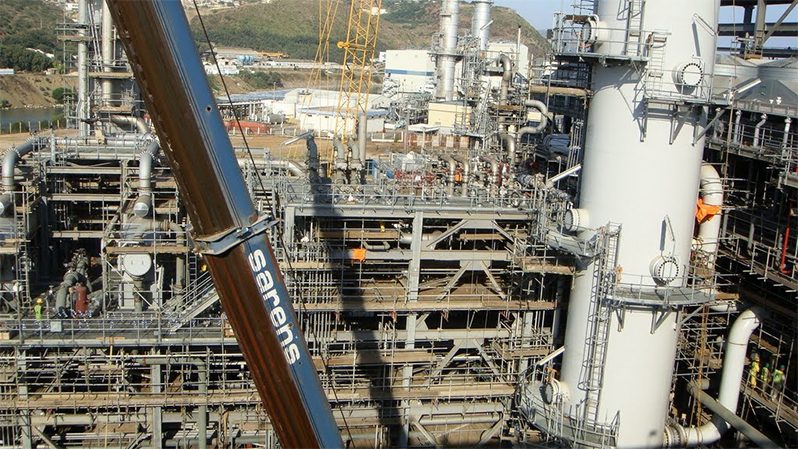In 1956, the enormous Hassi R’Mel gas field was discovered in Algeria, with gas production commencing in 1961. The field is not only the largest in Algeria, but also one of the largest in the world. SONATRACH, Algeria’s state-owned oil and gas company, is Africa’s first hydrocarbon group and the pioneer in LNG technology. In 1964, the company started production at La Camel LNG (Arzew – GL4Z), the first LNG plant operational in the world. Shortly thereafter, in 1972, the company launched the Skikda LNG plant (GL1K) to export LNG, Ethane, Propane, Butane and Natural Gasoline. The LNG complex was erected at Skikda, a city in north-eastern Algeria on the Mediterranean Gulf of Stora, 500 km east of Algiers. The 227 acre site is part of the Skikda Industrial Zone, which spans over a massive 3,100 acre area and houses 7 major industrial complexes.
The plant was constructed in 3 phases, with the first phase involving 3 trains of approximately 1 MMTPA capacity each (dubbed Skikda GL1K – units 10, 20 & 30). Technip was contracted to build the plant using the TEAL liquefaction process. In 1981, the second phase of development at Skikda was completed, after experiencing 6 years of delay. Prichard Rhodes were contracted to construct 3 trains each (dubbed Skikda GL2K – units 40, 5P & 6P), employing Prichard’s PRICO technology. The 1 MMTPA capacity train 40, was built adjacent to train 30 and shared the existing utilities. The other 2 trains, of capacity 1.25 MMTPA each, were built at the opposite end of the facility, separated from the first 4 trains by the storage tanks. In the 1990’s, all the 6 trains of the plant was revamped under a modernisation programme, with the production capacity of the facility enhanced to 7.68 MMTPA.
On January 19, 2004, a massive explosion occurred at train 40 during routine boiler maintenance, claiming 23 lives and injuring 74 others. The explosion triggered an intense fire, as it ignited a vapor cloud of leaked fuel above the plant. The flames completely destroyed trains 20, 30 & 40, raised several buildings to the ground, as well as partially damaged the loading facilities. Trains 10, 5P and 6P were subsequently restarted later in the year. The incident was the worst accident recorded in the history of LNG.
The Skikda Industrial Zone is a premier industrial site of Algeria, providing employment to almost 12,000 people. By 2030, Sonatrach aims to add revenue of $68 billion and contribute it equally between national wealth and renewal of reserves, production capacity, staff training and development of expertise in the Company. The company funds and sponsors various scientific, economic, sports and cultural projects in the country. The SONATRACH-Tassili Foundation concentrates on the protection of the environment, animal and plant biodiversity and tangible and intangible cultural heritage.
OWNERSHIP (Equity %)
| Sonatrach | 100.00% |
General Data
| Estimated Capital Cost (USD) | NA |
| Plant Type | Onshore Stick-built |
| Plant Stage | Train 4 – Non-operational Train 5 – Operating Train 6 – Operating |
| Final Investment Decision (FID) Year | NA |
| FEED Contractor | NA |
| EPC Contractor | Black & Veatch (previously, Prichard Rhodes) |
| No. of Trains / capacity | 3 Trains / Train 4 – 1.0 MMTPA, Train 5 & 6 – 1.25 MMTPA each |
| Production Start Year | 1981 |
| Products | LNG |
| Gas Type | Non-associated Gas (NAG) |
Technical Data
coming soon…
Refrigeration Train Configuration
coming soon…
Key Facts
- The Pritchard Rhodes PRICO process uses a single refrigerant fluid with a single process, employing an axial compressor to circulate the refrigerant. The required temperature difference at the cold end of the cryogenic exchangers is attained using Joule-Thompson expansion. Beneficial energy efficiency is achieved by using a refrigerant composition with a temperature curve of refrigerant vaporization parallel to the temperature curve of natural gas condensation. The refrigerant is cooled at 30°C using seawater at the discharge end. The condensed heavy hydrocarbons are separated from the vapor phase in a discharge separator and the liquid and vapor phases of the refrigerant are remixed at the entrance of exchangers.1
- On January 19, 2004, an explosion at the Skikda LNG plant consumed 23 lives and left 74 injured. The explosion destroyed three out of the six liquefaction trains, damaged a nearby power plant and resulted in the shutdown of a 335,000 bbl per day refinery. Some damage was also caused to the neighbouring industrial facilities. Initial reports suggested a fault in one of the boilers, however, investigations indicated that a large vapour cloud of hydrocarbons released from a pipe, was ignited during the accident. Train 6P subsequently re-started in May 2004, while trains 5P and 10 resumed operations in September 2004. Trains 20, 30, and 40 were destroyed in the incident, together accounting for approximately 50% of the capacity of the facility. The damage was estimated to have cost approximately $690 million after adjusting inflation till 2018.2,3
- In the 1990’s, revamping and expansion work was initiated under Sofregaz/GdF management. However, the work was deemed unsatisfactory and the contract was subsequently terminated in March 1997. Kellogg was hired thereafter to complete the operation within a year.4
Source:
1. Ainouche A. ‘Optimization Of Skikda LNG Plant Operation Using A Mixed Non-Linear Programming Model’, 14th International Conference & Exhibition on Liquefied Natural Gas (LNG 14), Doha, Qatar, March 2004
2. ‘Explosion at Sonatrach’s Skikda LNG Export Plant’, Plant Maintenance Website, 22 January 2004
3. ‘Report sheds new light on LNG blast in Algeria’, Alexander’s Gas & Oil Connections
4. ‘Algeria – The LNG Export Plants’, The Free Library Website, 1999





















































